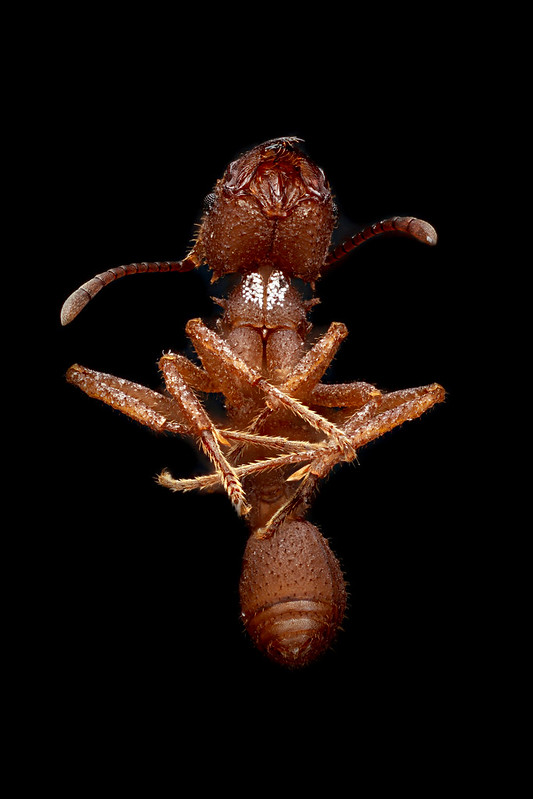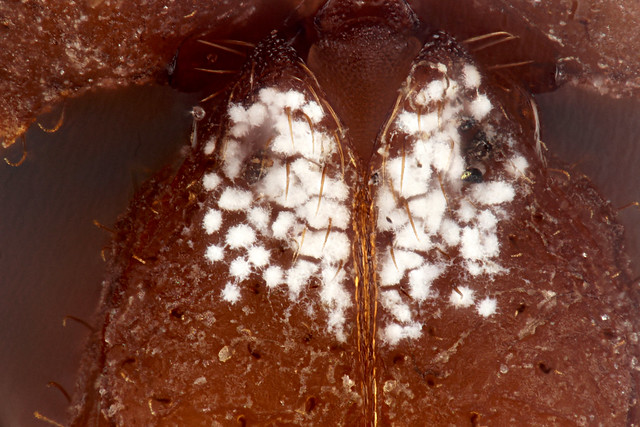Filmed on Jan 28th 2017 during the dry season. Smithsonian Tropical Research Institue (STRI) Barro Colorado Island (BCI), Panama.
Leafcutter ants are an impressive group with more than 40 different species. All evolved and diversified in the New World at around 12 million years ago. Phylogenetic evidence suggests their evolution could go back as far as 50 million years ago when America separated from Africa. A mature colony can have more than 8 million workers collectively farming a subterranean fungus. Their organizational complexity marvels us all. Here in this short observation you can see a leaf cutter ant colony doing many of their classic leafcutter ant things including harvesting of the outer fuzzy leafy layer on the seeds of the legume tree Dipteryx panamanensis. Although the plant material is much harder to harvest it must be rich with nitrogen (4:05 into the recording).
The leafcutters establish very long supply columns transporting leaves and other digestable plant material to the fungus inside their nests. Workers organize themselves with impressive eficiency. Myrmecologists use the scientific term task allocation to describe different jobs ant workers carry out. Those that forage and cut leaves far away from the colony carry their cargo to a certain exchange point and return back to their cutting location. Just like camels on the Silk Road shuttling between caravanserays, other workers pick the cut leaves and transport them until another exchange point. You can see one such exchange station through 1:13 of the recording.
Leafcutter ants are a source of curiosity. Many natural history museums and nature centers rear them in captivity such as the Insectarium in Montreal. In fact ant keeping is a booming hobby. Thousands of ant enthusiasts maintain ant colonies in artificial nests including weaver ants.
Leafcutter ant colony (Atta cephalotes) – Insectarium, Montreal from Uzay Sezen on Vimeo.
Fungi play an immensely important role in nutrient cycling by decomposing organic matter. Symbiotic partnership between a subterranean fungus and leaf-cutter ants has lead to one of the most prolific herbivory complex ever. A mature leaf cutter ant colony can consume an amount of leaves equal to a weight of a cow every day.
Inside the nest workers chew the leaves into a pulp and mix ant poop as fertilizer before feeding the yummy mix to the fungus Leucogaricus gonglypherous, and associated bacteria. The fungus grows like a continuous bioreactor occupying many nest chambers. As the fungus and microbes break down the leaves, it produces fruiting bodies packed with nutrients for the ants to consume.
The following video recorded by Robert Schofield and his co-workers as a as a supplementary to their study summarizes the many tasks workers carry out inside the nest. These include processing of leaf fragments by holding, licking, scraping, puncturing, adding of abdominal secretions, inserting, inoculating and caching:
How did this co-evolutionary process begin? A strong clue comes from a temperate zone ant species that lives in southeastern United States. The University of Connecticut researchers suspect that this temperate zone ant species Trachymyrmex septentrionalis might be the closest ancestral form of leafcutters in Americas. This ant does not cut fresh leaves. Instead it uses dead plant material to cultivate their fungus. Such plant material is very abundant and convenient source for storage during long winters. When the spring comes workers of the Trachymyrmex septentrionalis collect frass from caterpillars and deposit them to their fungal garden. Caterpillar frass may serve as a form of pre-processed leaf material helping to boost fungal activity.
Clearly the ancestral form of the fungi have evolved to attract ants for protection and dispersion of its spores. In return the fungus provided nutritious reward. Ants are great resource utilizers. Once they discover a resource they will use it very efficiently. A fungus that grows and produces edible fruiting bodies that feeds on dead plant material must have been an excellent resource. Thus in the nest ants must have made the transition to domesticate and cultivate mushroom gardens. Just like our domesticated plants and animals the fungus has become a highly specialized species that does not exist in the wild alone outside the ant nests.
We now know that the ant-fungus mutualism has a strong third partner: bacteria. Most leafcutters carry symbiotic bacteria on their chest plates that produce antibiotics. Ants rub these protective chemicals onto the fungus to protect it against fungal parasites. Characterization of the anti-fungal and anti-biotic properties of these bacteria is most certainly going to open new avenues for biomedicine.
A proplueral (chest) plate of a Trachymyrmex septentrionalis worker bearing antibiotic producing bacteria:




3 Comments
Great video, Uzay, and an excellent write-up on leafcutter ants. It’s much better than what I managed to record on BCI. I’ll be sharing this with my forest biology class tomorrow.
Thank you for your kind words! A tripod creates wonders in recording such events. Please do share it with your students. It would make me very happy.